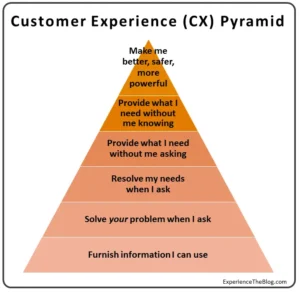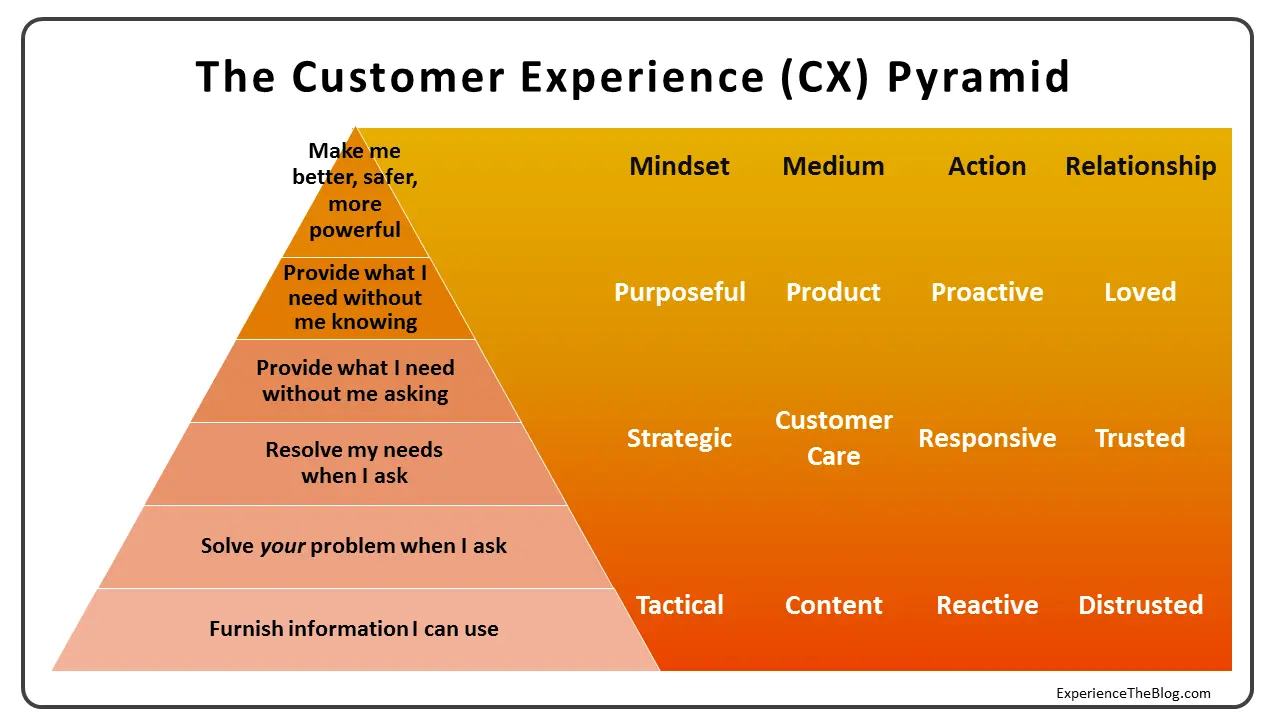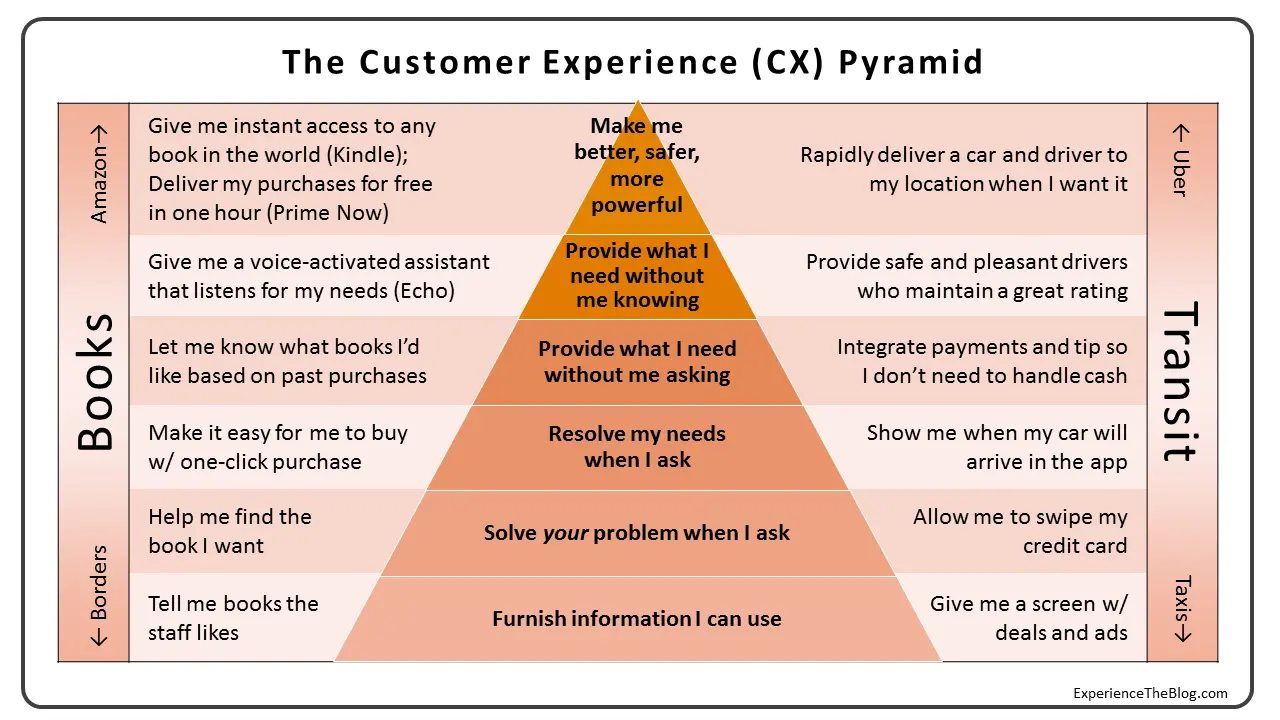It is no secret among Customer Experience (CX) professionals that most CX efforts fall flat. Forrester found that only 25% of CX professionals say their companies’ CX programs actually improve customer experience, and Avaya recently published a study indicating that 81% of organizations have seen their Customer Experience Management (CXM) initiatives fail in the last three years.

The problem is that most companies view Customer Experience as a program and not a purpose–something to be assigned to a couple of employees while the rest of the company goes about its business improving efficiency, acquisition and margins.
When one considers the hierarchy of experiences brands can furnish customers to satisfy their needs–“The CX Pyramid”–it is easy to understand why so many CX efforts fall short. Most of today’s CX initiatives focus on incremental change in existing processes, which limits those programs to solving the least important needs at the bottom of the pyramid. Finding CX gaps and fixing them with more content on websites, new training for customer service representatives or greater self-service options certainly offers benefits, but nowadays these actions are table stakes rather than ones that allow brands to differentiate themselves from the competition.
Today’s innovative companies begin their Customer Experience design in a different place–not with customer perception of existing products and services but with an understanding of consumers’ evolving needs and expectations. As we will see, the most powerful companies today simply rewrite the Customer Experience from the top of the pyramid down, leapfrogging established competitors by delivering experiences that are more integrated, robust and powerful.
Introduction To The Customer Experience Pyramid
Before exploring examples of brands that succeed at the upper reaches of the CX Pyramid, let’s first briefly explore the pyramid from bottom to top. Each step represents a greater level of customer need that brands can solve with product and service experiences:
- Furnish information I can use: The lowest form of CX is to give customers information so they can solve their own problems. If I suffer a flat tire, a brand may offer instructions on how to swap it for the spare. Or if I have my identity stolen, a company may provide the twenty steps I can take to recover. This sort of information is good to know, but it is a weak customer experience that does little to satisfy customers or create differentiation for brands.
- Solve your problem when I ask: Let’s face it, most customer care nowadays is designed not to satisfy my needs but to solve the company’s issue–namely to get me off the phone or stop me from complaining on Twitter as quickly as possible. Even worse, companies like Comcast are turning their customer care employees into sales representatives, holding them responsible for quotas of new revenue-generating services and for retaining customers who simply wish to cancel. This sort of experience tells customers their needs are less important than the company’s.
- Resolve my needs when I ask: There is a difference between handling a customer’s immediate issue and resolving their needs. If a repair service replaces my flat tire with a spare but I still have to get the damaged tire repaired, my needs have not been fully resolved. Or if my bank puts a hold on my checking account after my identity has been stolen but I still have to call the credit card company to cancel my card, the bank has not resolved all my needs. To fully satisfy customers’ needs and not just process their requests takes time and care, but it furnishes a more powerful brand experience.
- Provide what I need without me asking: Not every company or service can do this, but providing what a customer needs before they ask is a powerful way to demonstrate customer commitment and win loyalty. When your credit card company catches fraud before you do, alerts you and has a replacement card in the mail before you even ask, that is a memorable experience. Or consider our tire example–would some be willing to pay more for a service that removes all worries by monitoring their tires, knowing when a flat is about to occur and replacing it overnight in the customers’ driveway? Providing experiences that protect customers from harm or help them to exploit opportunities before they ask furnishes brands with strong, trusting and emotional customer bonds.
- Provide what I need without me knowing: As we near the top of the CX Pyramid, we arrive at levels of experience that can only be provided when brands rethink products in the age of big data, mobile connectivity, social media and the Internet of Things. Nest thermostats offer an Auto-Away feature that raises and lowers my home’s temperature, saving me money without me even knowing it is acting on my behalf. OnStar Automatic Crash Response can estimate the severity of a car accident and alert authorities, even if I cannot. Google Now monitors my activity and furnishes updates I may need but did not request, such as the delivery status of a package (automatically derived from an email confirmation I received) or the directions to a business (for which I recently searched). The future of CX isn’t merely reactive and responsive but proactive and serendipitous, which means the brands that will win our trust, loyalty and advocacy will solve problems or harness opportunities we do not even know we have.
- Make me better, safer, more powerful: Much like Maslow’s hierarchy, this self-actualizing (or brand-actualizing) level is more aspiration than reality in most verticals, but there are plenty of examples to be found among the world’s most powerful brands. Apple achieved this with the iPhone and iPad, giving consumers devices that allowed them greater access and control of information and communication in a more intuitive fashion than was previously imaginable. Facebook, Twitter, Snapchat and others have given people incredible power to broadcast information, build reputation and enhance relationships. And the rapid growth and adoption of collaborative economy companies such as Uber, Airbnb, LendingClub, Kickstarter and others is due to the way these innovative startups furnish consumers with more power–over assets, expenses, income and experiences–than traditional providers and business models can match.
What’s Wrong With Customer Experience Management Today
The CX Pyramid furnishes a lens through which to view the problem with many of today’s CXM initiatives. Too many tend to be:
- Backwards-looking: Many CX programs strive to identify and patch problems in the existing product and service environment rather than seeking ways to significantly change that environment.
- Reactive: CX initiatives often implement ways to improve the experience for customers who hold up their hands and ask for help rather than seeking ways to furnish experiences that proactively prevent issues or furnish solutions.
- Tactical: Many CX programs have the ability to change tactics rather than being empowered to rethink the organization’s strategic approach to meeting customers’ most important and ever-changing needs.
- Narrow: While there’s nothing wrong with housing the CX team within the Marketing or Customer Care departments (which four in ten organizations do), the impact is reduced when these programs only influence change within those silos rather than encouraging (or requiring) collaboration across departments.
- Self-interested: Companies that put the customer first and evaluate CX in terms of customer perception will have stronger outcomes than those that seek to change CX only in ways that improve corporate financial outcomes.

Companies that make profound leaps forward in Customer Experience are the opposite. Brands like Amazon, Apple, Nest, Uber, Zappos, USAA, Square and Costco have CX efforts that are forward-looking, proactive, strategic, broad and customer-centric. Their results are realized not in incremental improvements to customer care or existing products but with profoundly different experiences that satisfy a higher order of customer needs.
How Amazon and Uber Rewrite Customer Experience From the Top Down
Compare the CX approaches taken by Amazon and Borders. Whereas Borders’ CXM process sought to make the existing bookstore experience more pleasant with cafes, Amazon’s approach to CX was to start fresh and focus at the top of the CX pyramid. While Borders was achieving the top-rated CX in the country, Amazon was re-imagining the Customer Experience of shopping in a digital world. And when Borders went bankrupt, Amazon was still rising, collecting more customers and building stronger relationships.
How could the company with the top-rated CX in the country fail, beaten by the upstart Amazon? The differences in Amazon’s and Borders’ outcomes can be seen when comparing how their CX improvements fit into the pyramid.
While Borders offered shelves of its employees’ favorite books (“Furnish information I can use,” the bottom rung of the CX Pyramid), Amazon offered a recommendation engine to provide personalized selections for its customers (“Provide what I need without me asking,”) While Borders offered cafes (a move that had more to do with solving its own problem of increasing share of wallet than with satisfying consumers’ demand for still more coffee shops in the world), Amazon was launching the Kindle, a device that gave consumers the power of instant access to literature and information with greater mobility.
Borders optimized the customer experience for bookstores in today’s business model, while Amazon envisioned new products and services to provide the customer experience of the future. As today’s business models withered against digital solutions that furnished experiences higher in the CX pyramid, Borders was left with the best customer experience that no one wanted.

The same can be said for Uber versus the taxi industry. Uber did not start with the existing taxi system, study consumer complaints and launch a new livery company with cleaner cabs or friendlier drivers; instead, Uber rewrote the CX of urban transportation. Compare this to the “innovations” offered by taxi companies in the past two decades, such as card readers that allowed consumers to swipe their credit card (while earning a glare or outright hostility from the driver) and video screens that did little for riders but helped the taxi companies earn revenue from advertisers.
While taxi companies were largely ignoring their CX problems or providing solutions at the very bottom of the CX pyramid, Uber went from unknown startup to $40B company by starting at the top of the pyramid. Uber’s mobile application, with its real-time driver location data, ratings system and integrated payment platform all provided solutions that fit into the upper portion of the pyramid. But the real killer attribute of Uber is found all the way at the top of the CX Pyramid–the ability to immediately call a taxi to my current location. Giving that power to consumers has made standing in the gutter waving at passing yellow cabs seem as hopelessly outdated as the horse and buggy. Uber’s on-demand service is an example of how the Customer Experiences that really matter are ones that “Make me better, safer, more powerful.”
Whether one compares the top-rated and bottom-rated companies in Customer Experience, or the brands that are most rapidly lifting their brand equity versus those that are not, or the most trusted versus the most distrusted companies, it is easy to see how the brands that succeed do so by providing experiences that solve higher orders of consumer needs. The future belongs to companies that understand that CX is the most powerful force for building brands in the era of splintering media, diminishing consumer trust, empowered consumers and powerful WOM.
In the future, brands will not succeed because they have CX programs. They will succeed when CX is driven from the top, is integral to company culture, guides the behavior and actions of all employees, spans silos, and ensures that products and services satisfy consumers’ most important needs. Tomorrow’s success stories are today focusing at the top of the pyramid, while the future Kodaks, Borders and Radio Shacks of the world are all anchored to the bottom.





